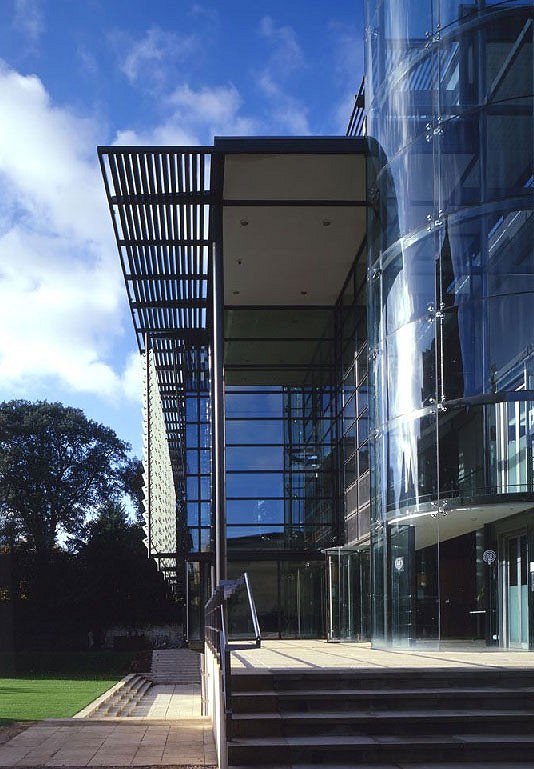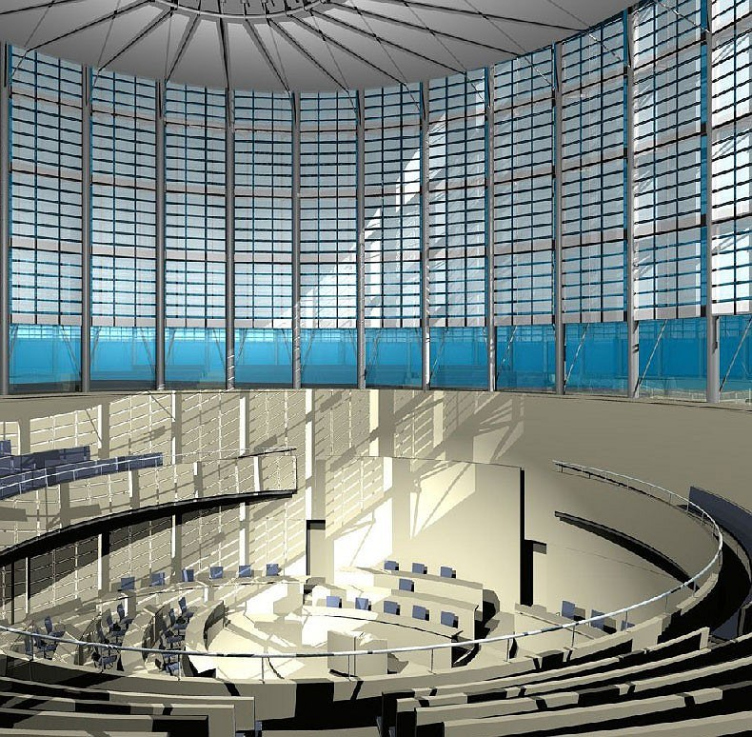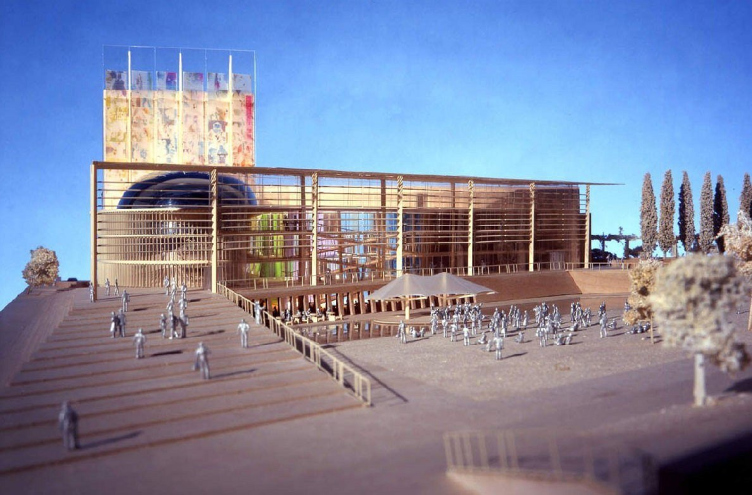York, London and Shanghai with a diverse portfolio of super tall skyscrapers, museums, universities, banks, hotels,
convention centers and airports all over the world. David Leventhal jointed KPF in 1979. He is a partner-in-charge of design at the London office, which he founded in 1989 together with Lee Polisano, now the president of the firm. David designed award-winning projects at Oxford University, the London School of Economics, the Parliament House and the National Theatre in Cyprus and high-rises in North America, Europe and the Middle East. These projects incorporate low-energy design strategies and exemplify the firm’s commitment to sustainable architecture.
KPF is now working on three projects in Moscow. In 2006, the firm was invited to take part in new Administrative
Business Complex competition in St. Petersburg for Gazprom, Russian energy giant. David expressed his amazement and
disappointment with Gazprom’s decision to build a 400-meter tall skyscraper in close proximity to the historical city center. Being familiar with the horizontal and historically cohesive urban character of St. Petersburg, it became a moral issue for KPF partners to decline the challenge to design a skyscraper in a place where it does not belong. We met with David Leventhal at his company’s multistory office in the Economist building, the home of the famous namesake.
You went to Harvard art school but graduated from architecture. What determined your choice?
I’m originally from Boston and if you live in Boston you are expected to go to Harvard. In my undergraduate program, I specialized in fine arts and was debating whether to become a museum curator or an architect. When I finished the undergraduate program I still didn’t know, so I went to work – first at the Metropolitan Museum of Art and then for
Pietro Belluschi, a famous Italian-American architect. I learned what it is like to be an architect and was much more excited about architecture, so I went back to Harvard. For me the best professor there was Michael McKinnell, a fantastic teacher and the architect of the City Hall in Boston, which I think is the best example of 20th century architecture in Boston. I graduated in 1978.
How did you hear about KPF?
I came to New York right after Harvard and saw the new ABC Television Studio on West 67th Street. I found out that it was a building designed by a company called KPF, so I went there and was interviewed by two KPF founders, Eugene Kohn and William Pedersen. They liked my work and we shared a great passion for Alvar Aalto’s architecture. They were not hiring then and asked me to come back in the future. I started working for Cain, Farrell & Bell, the successors to the famous beaux-arts firm of McKim, Mead and White. They had original drawings by Charles McKim, which attracted me to their office in the first place. I worked there for about 9 months. One day a professor from Columbia University came
to the office because he found out about these drawings. He asked the partners if he could have them and they gave these
priceless drawings away, just like that. At that point, I knew I had to leave since the office was not very passionate about
architecture. I called KPF and almost 30 years later, I am still here.
Do you ever contemplate about having your own firm?
Absolutely not! What is so great about KPF is that from the very beginning I knew that I was with the people who share my
thoughts and passions. My voice was heard, my opinions respected and whenever I was with the clients by myself I could speak for the firm. I could always say – “we”.
Do skyscrapers remain the main focus of KPF’s workload?
They are one of our focuses. We continue to work on very tall and exciting projects, such as Shanghai World Financial Center, a 101-story tower. It’s primary form is an intersection of a square plan extruded and two sweeping arcs, which taper to a single line at the apex. The top is pierced by a square opening to relieve wind pressure. It is under construction now and is expected to become a new icon on the Shanghai skyline. However, for us the real focus is not just producing tall iconic buildings, but working in cities. Of course, skyscrapers are now a big part of working in cities. It is important how our urban projects contribute to city life and how it is for the people to work inside of these buildings.
Let’s talk about your projects in Russia.
We have three major projects in Moscow. Two projects are direct commissions and one we won through a competition. The first project is with the development firm called Horus Capital. The second project is Park-City. It is located right across the river from the White House and next to the Ukraine Hotel on 36 acres (15 hectares) site. There we are working on the master plan and the design of several new buildings. The third project is several office towers along Kutuzovsky prospect for Alpha Bank and ZAO Inteco.
What are these projects like?
The Horus project is right on the Garden Ring. At first, we designed a tall building that featured horizontal planes rising gradually into vertical planes. The design was inspired by Russian architecture of the 1920s and 30s. When we presented this scheme, we were told that our site was not reserved for a highrise, so we went back to the drawing board. The second proposal is very different. It has a very hard edge on the outside protecting a curving, oasis-like interior space to the rear. Straight rays coming from an imaginary point deep down within the earth and form the basis for the façade. Dynamically angled glass panels evoke the impression of a great burst of energy and excitement. The lobby is very open and accessible to the public for restaurants and retail. We are working with designer Ron Arad on a very expressive sculptural piece that will unify many architectural elements within.
At Park-City we proposed two main organizing urban gestures – a new boulevard, parallel to Kutuzovsky Prospekt and the diagonal axis, which picks up the angle from the late 19th century Badaevsky Beer Brewery building. This axis runs straight, past the water’s edge over a highway and terminates in a very dramatic 35-meter cantilever. This dynamic structure will have a spectacular viewing platform, restaurants and outdoor spaces along the river. The office complex on Kutuzovsky
prospect, near Victory Park, is a composition of organic towers and lower terraced buildings that merge with the landscape,
creating a public space with an underground retail link to the Metro.
What other architects work with you on the Park-City project?
Rafael Vinoly is designing three residential towers along the river. Other buildings are designed by a Beirut architect Nabil Gholam and young London-based Brisac Gonzalez, who apprenticed at our London studio many years ago.
Many major projects in Russia are being designed by foreign architects. Do you feel you have the advantage over the Russian architects?
I can only tell you about KPF. We have a great passion for working in cities and we have a tremendous respect for local
culture. Most importantly, we know how to interpret a local condition from an international perspective. We have a very
diverse international portfolio of successful projects.
How frequently do you go to Russia?
I’m very involved with the Horus project and now we are beginning to collaborate on a couple of new projects with them. We have meetings every two weeks, alternating between London and Moscow. I go to Moscow at least once a month. I have been there ten times. Moscow is a difficult city to say that one knows it well, but I think I am beginning to understand it more and more. Each time we go, we try to visit a museum, a local site, a train station or a monument. Our client is very passionate about architecture so whenever we have an hour between meetings, we go see something.
Have you seen anything interesting built there recently?
There is a lot being built, but to be honest, much of what one sees just passing by is not incredibly exciting. I suspect there are some interesting projects there, but they are not at the forefront of the city. What interests me more are buildings from the 1920’s and 30’s by the constructivists. The ones that I liked most are by Melnikov – his house and the clubs. They are done with a fantastic imagination and a great sense of taking a program and making something very special. Also, I’ve been several times to the recent exhibit of Richard Pare photographs at MoMA, so I made a list of buildings and every time I go to Moscow I try to visit something new.
Is it difficult to work in Russia?
What is special about Russia is that so many things are constantly changing. Even the building codes are changing. The
notion of a tall building is always being reconsidered. Atria in tall buildings are not clearly defined. The fire codes are very conservative because there are no precedents for many types of construction. Even with our international experience, we have great difficulties to prove that our solutions are safe and valid.
How would you compare working in Russia to China or the Middle East?
Each place is different and it has a lot to do with where each country stands in the cycle of development. In the Middle East,
in places like Abu Dhabi or Qatar they are far ahead of Russia. China is right behind the Middle East and Russia is behind China. Recently these countries reissued their building codes, so they have, for example, real high-rise codes. In Russia, we still run into so many uncertainties.
Do you see any particular shifts in the demands of your clients for innovative ideas?
Interestingly, some of the countries in the Middle East are the ones that are pushing for new ideas. For example, our client in Abu-Dhabi for the ADIA Headquarters pushed us to come up with the workspace that would be the best in the world and actually encourage people to work together. Each floor has an open plan, zones for interaction and meetings within a central landscaped atrium and a series of sky gardens. There was also a desire to fit this new building into the local context. The curved form of the tower is related to fluid forces of the waterfront site. The office floors are connected with convenience stairs, expressed in elevation as a slim glass tower. It breaks the bulk of the building and proportionally mimics
many tall minarets in the city, but in a very suggestive, abstract way. The building is wrapped in ribbon-like surface of doubleglazed curtain wall with horizontal shading devices, which is both economical and beautiful.
Do you foresee any particular changes in the way tall and super tall buildings are going to be used in the future?
The world’s densest cities like New York, Tokyo and Hong Kong are also its most energy efficient. For sustainable reasons alone, we must live more densely. More and more, tall buildings are used for mixeduse programs such as hotel, residential, commercial and offices. It is a very economical way to occupy a particular site. This strategy leads to substantial energy savings because an excess heat load, for example from an office user could be used to heat an apartment. Tall structures create new important social spaces, such as elevator transfer floors or sky-gardens. Many cities in the Middle East are very spread out and tall buildings make them feel very exciting and urban. Tall buildings are identified with progress and prestige and people are willing to pay a very high price to live or to work in them.
In other words, cities will grow upwards and Moscow is no exception.
Sure. Tall buildings make economic sense in many parts of the world. When skyscrapers are grouped together and are supported by developed infrastructure and especially public transportation, they form very exciting dense city centers that identify the greatest cities around the world today. That is why Moscow needs to build high, but obviously, each building should be sensitive to its surrounding. There is another important point. A skyscraper is defined by an aspiration, one that intends to link earth and sky, the new dimension of the cities of this new century.







































